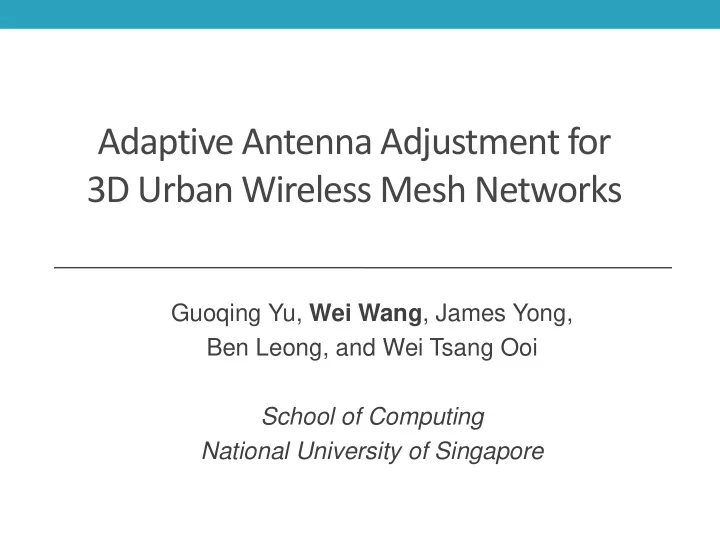

Adaptive Antenna Adjustment for 3D Urban Wireless Mesh Networks Guoqing Yu, Wei Wang , James Yong, Ben Leong, and Wei Tsang Ooi School of Computing National University of Singapore
Introduction Most existing mesh networks are deployed in a 2D plane . The default vertically-upright orientation of antenna works well in 2D.
Introduction 3D urban mesh networks Clearly, vertically-upright orientation no longer optimal. How do we find good antenna orientation ?
Challenges The search space of orientations is HUGE! • Antenna orientation has 2-degree of freedom • Complexity increases exponentially with the number of antennas • Take time to probe an orientation Impractical to probe all the orientations. Need an efficient way to find a good orientation!
Our Contributions • Design and implement low-cost mobile- antenna nodes (called Dyntenna node) for a 3D urban mesh testbed • Measure the effect of antenna orientation in 3D urban mesh • Develop a basic antenna adjustment algorithm to find a good orientation and improve throughput
Dyntenna Node Horizontal beamwidth: 360° Rubber-duck Vertical Alix board, running antenna beamwidth: 90° OpenWRT and Click < $100 Moving range: -45° to +45° Motor, Y-axis USB and Coaxial Motor, X-axis
3D Mesh Testbed Min Level-3 Max Level-13 5 Dyntenna nodes The others use vertically- upright antenna orientation
RSSI Map An intuitive way to describe the effect of antenna orientation on RSSI for a link -45° to +45° range 11 steps in each axis, 9° of each step Total 11x11 = 121 antenna orientations An 11x11 RSSI map
Key Observations The default vertical orientation may NOT have the optimal RSSI. Orientation w ith m ax RSSI RSSI of vertical orientation Median RSSI difference between vertical and optimal orientations is about 5dB .
Key Observations RSSI values vary smoothly with antenna orientation. Idea: develop efficient algorithm to estimate the RSSI map with small number of probes.
Antenna Adjustment Algorithm Goal: find the orientation with maximum RSSI , using the least probing steps. ? Only one Dyntenna moving at one time
Algorithm Overview RSSI Map Initialization Interpolation Restart? Maintenance Probing Stop? • Check whether a better • Stop probing if we fail to find • Among unknown orientations, • Anchor orientations • Interpolate and estimate the probe the one with maximum RSSI of unknown orientations maximum RSSI is found. higher RSSI than recorded RSSI. If yes, then go back to maximum RSSI after 3 interpolation and repeat. iterations. Go to Maintenance phase.
Anchor Orientations A trade-off: • Fewer anchor orientations • Larger error of subsequent interpolation • More anchor orientations • May not be necessary Best , according to offline simulation
Linear Interpolation • Delaunay-triangulation based • Fast • Sufficiently accurate • Also tried Cubic Interpolation • Computationally more expensive • No big improvement in accuracy
Multiple Links and RSSI Maps Dyntenna node may have more than one neighbor • Take the sum, and get “Aggregate RSSI Map” • Ignore the orientations that may break a link, e.g. RSSI < 9dB
Evaluations • 3D 20-node urban mesh testbed • MIT Roofnet (Srcr) as the routing protocol • How much throughput improvement can Dyntenna achieve? • Single-hop Single-flow (92 samples) • Multi-hop Single-flow (260 samples) • Single-hop Multi-flow (15 samples)
Evaluations Single-hop, Single-flow • 92 samples • 26% of them have median throughput improvement of 31%
Evaluations Multi-hop, Single-flow • 260 samples • 35% of them have median throughput improvement of 46%.
Evaluations Dyntenna • Originally 3-hop route by Roofnet • After antenna adjustment, Roofnet finds a better 2-hop route
Evaluations Single-hop, two-flow • 15 link-pairs Better throughput
Evaluations Vertical orientation Single-hop, two-flow • 15 link-pairs
Evaluations Vertical orientation Single-hop, two-flow vs. Antenna adjustment • 15 link-pairs • Dyntenna can improve throughput or fairness or both.
Conclusion • Default vertical antenna orientation is rarely optimal for 3D urban mesh network. • We design and implement Dyntenna to automatically find a good orientation. • Dyntenna can sometimes greatly increase throughput by choosing the orientation with max RSSI.
Future Work • Multi-hop multi-flow • Integration with routing protocol (and rate adaptation) • Simultaneous adjustment of multiple Dyntenna nodes • Application to 802.11n radio with multiple antennas
Thank you! Questions?
Antenna Radiation Pattern • Omni-directional, but in 2D only.
RSSI is Stable
RSSI of 9dB as cutoff
When to stop? • Local Minima Still carry on probing, even if no improvement of max-RSSI • Stop probing if no improvement in last K probes • K=3 , according to simulation • On average, need about 10 steps.
TODO • Flow chart between pg 10 and 11. • Check “Optimal” • Mention “LOCK Dyntenna node”
Recommend
More recommend